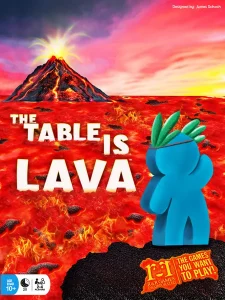The Table is Lava Board Game Review

By MARK WILSON

Year Published: 2018
Players: 2-4 (2-5 w/expansion)
Playing Time: 20 Minutes
Once in a generation, a game comes along that’s so profoundly innovative and fun that you simply have to stand up and cheer.
The Table is Lava…is probably not that game.
Psychological Tricks
I started by deflating things a bit up there, but for a potentially unexpected reason. You see, I love this game and I want to gush about it. But I suspect that I’d oversell it for many gamers if all I did was praise it. So we start by establishing that, no, this game isn’t the most spectacular game out there in numerous ways.
But what it is, is loads of fun.
What Does “Fun” Mean?
There’s no way I fully answer this question with any rigor, so I’m going to get at it obliquely.
We kind of know “fun” when we see it, don’t we? We could get into the shifting preferences of hobby gamers, and how there’s no such thing as a perfect game for everyone. Or how there are different types of fulfillment that games can create, and that they’ll manifest differently in people. And that’s all true.
But if I showed you a 30-second clip of people playing a game, then asked for your gut reaction on whether or not they were enjoying it (or, perhaps, which ones were and weren’t), we’d all be pretty accurate.
Smiles, positive body language, laughter, wry smirks and contented sighs…we know the signs when we see them, and can interpret them accordingly. This, to me, is what makes a board game fun.
The Table is Lava has been one of the most consistent games I’ve ever played at eliciting these universal “I’m having fun” reactions in people.
The Table is Lava – The Premise
You have a small hand of cards. You fling these onto the table, and they have to connect to one another or they’re lost to the lava. On the cards are a number of meeples. Your hand will mostly have your color of meeple, but occasionally others. If a card is successfully landed on the table, you can place meeples on them that correspond to the colors.
You can also use cards for murder, flinging them with abandon at your rivals’ meeples that are already safely on the cards. If you knock them off the cards (or your own by accident), they’re lost to the lava.
Meeples standing up are worth two points at the end. On their side, one point. Your final card is only for violence; you can’t place meeples on it.
That’s not just a summary of the rules. I just taught you the whole game.
Coconuts Expansion
There’s a Coconuts expansion that adds a fifth player, and for some reason the pink 5P meeples are sometimes wearing coconut bras. Whatever; it’s gently thematic, I suppose.
No new rules; just the new player. If you think you’ll want to play with 5P, it’s worth getting.
The only big gripe I have here—and really, with the game as a whole—is that the new pink meeples and cards are WAY too close in color to the red ones in the base game. It makes the game nigh-unplayable in low light, and not ideal in any setting.
House Rules and Letting Go
The rules are very simple, but they don’t cover a few edge cases. What if your card lands upside-down? What if you land on top of other meeples and the card is lying at an angle?
I’ve seen people decry this lack of rigor in the rules. These are shallow criticisms, though, borne of expectation that rule books dot every i and cross every t. Surely, they seem to say, we can feel at least a little indignant that they had the gall to leave out such obvious inclusions, right?
But here…we’re flinging cards around like crazy people, and the “game board” will eventually resemble what happens when you dump the game box upside-down and just let the components fall out. Exactitude is not necessary. Letting go of that control and enjoying the fun is all that’s required.
So how did I resolve the two edge cases I mentioned? I made up a house rule on the fly, and picked whatever I thought was funniest. So now, for example, we can accidentally build 3-D structures with cards on top of meeples or at weird angles, and it’s up to players to figure out how to situate their meeples on them. It’s great.
I’ve also seen some people get mildly anxious about potentially losing meeples or bending cards, and they’re anxious in regard to my copy of the game. I always remind them that games are meant to be played, and that I expect bent cards and lost meeples eventually with this game. Hell, I once launched a card that was millimeters from floating off a balcony, and it was probably the most intensely dramatic moment in the game…and it hadn’t even come close to knocking any meeples over, so all the drama was separate from the game’s mechanics.
Have you ever heard of a ragged old book described as “well-loved?” The same principle applies here. If I have a pristine copy of The Table is Lava in, say, five years, with no lost meeples or nicked cards, I’ll consider it a failure.
So this is that type of game. Weirdly, it’s the type of game where someone might say “great for kids and families!” But I haven’t played with kids or families, only hobby gamers. And it’s a great way to spell the more serious proceedings with something that is simply unremittingly goofy.
The Table is Lava – Conclusions
I haven’t introduced this yet to a tepid response. It’s too quick, too primordially joyful, to be hated. More frequently, people want to play again, or spy us playing from across the room and ask to play later in the evening.
I guess the criticism I might level at it is that it occupies a space in a larger “flick ‘em” game genre with peers and competitors with a lot more going on in them. If you want, say, a narrative to accompany your dexterity games, there are other options that have better emergent narrative elements. Flick ‘em Up, Catacombs & Castles, and Terror in Meeple City all qualify, and are meatier games that may scratch the same itch, and/or scratch it more deeply.
Additionally, some people simply aren’t terribly coordinated, and they know this, and so their play in dexterity games becomes a self-fulfilling prophecy of frustration. Frankly, the goofiness and short length of this one means that I haven’t really experienced this, across a few dozen unique players of the games. More frequently, it’s the terrible card throws that produce the wildest laughter from everyone. But I suppose it’s possible, especially since I’ve seen it in other games.
But I feel like those criticisms are ignoring what the game is trying to accomplish. It means The Table is Lava will bounce off of some who want that extra meat. But it will also please plenty who just want to smile a bunch, even if they’re terrible at hucking cards accurately across a table.
…
For more content, or just to chat, find me on Twitter @BTDungeons, or check out my other reviews and game musings!
Share
Recent Posts
Categories
- All (347)
- Announcements (4)
- Board Games (201)
- DMing (28)
- Game Design (16)
- Playing TTRPGs (21)
- Reviews (188)
- RPGs (141)
- Session Reports (90)
- Why Games Matter (9)